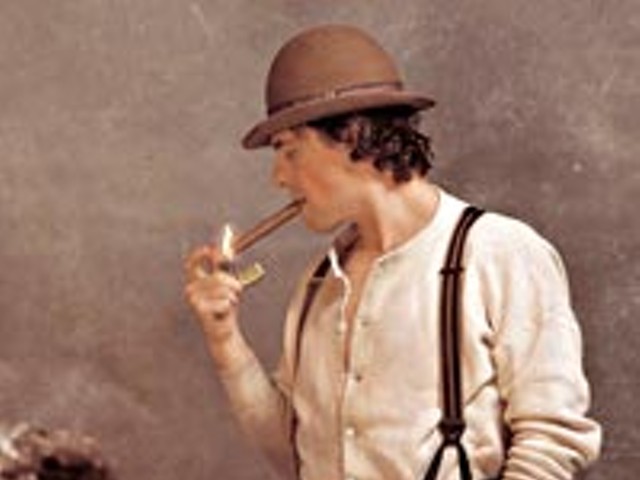Unpacking and deciphering the loaded imagery in Dana Bell’s seemingly stripped-down, flat pastel, Hollywood movie poster-like paintings on display at David Klein Gallery is a job for an art historian, a semiotician, a social philosopher — and a critic to boot. The arrival of the exhibition announcement in the mail sent the antennae up in anticipation of a head scratcher. It featured “Red Dress,” displaying a female in a crimson red, midthigh, cocktail dress (no jewelry, shoes or face) against a pale gray background that seems to siphon the color out of her tentative, equally pale flesh. Bell acknowledges being influenced by the paragon of New York painters like Alex Katz, whose “portraits” of his ruling class friends are famous for crisp, hard-edged angular forms and sanitary high bourgeois style. But Alex Katz’s figures at least have eyes, noses and mouths; their faces announce the fact that this is their theater of pain and their “beautiful” geometry of life is the prison they choose to inhabit.
In a sense Bell’s paintings are less interesting than Katz’s because they are philosophically ambiguous; the world they support is less carefully groomed. While beautifully executed, the paintings are austere in their suggestiveness. The full-length figures and their minimal, ambiguously composed gestures could be read in as many ways as there are viewers to read them. The “Red Dress” figure could be greeting the viewer, about to embrace the viewer, or simply posed to be scrutinized by the viewer, to be explored as a sign. The absence of facial features has a frustrating effect, giving the viewer a kind of vertigo, as if falling into the image, as in a bad dream.
The palette is less like Katz’s rigorous exploration of space and color and more like Milton Avery’s, another painter that Bell cites in her “artist’s statement” as an influence, and who, incidentally, was also an influence on Katz. Avery’s subtle pastel color field paintings seem to reside as a background to Bell’s figures. Bell’s paintings also have a similar philosophical disposition to Avery’s and seem to reduce the landscape to an emotional tone in the mind. Bell’s backgrounds are like an existential fog or stage that allows the figures to perform their isolated, ennui-ridden gestures for us in a private space — so no one else can see us or them.
Some of the figures have erotic elements, but only insofar as they suggest sexual potential. In two separate paintings, two women seem to be undressing. One is called “Strip Tease,” and the figures, dressed in black bra, garter belts and gray stockings, have an ambiguous gesture that could be interpreted as a seductive dance. The other, “Undressing,” has two women in generic street clothes, facing each other taking their tops off, revealing their amply filled bras. They are without erotic significance except that both are doing the same gesture at the same moment. Incidentally the titles of all of the paintings were composed by the gallery director and not by Dana Bell herself, telling us that the artist has no intention of interpreting the works for us and that they reside in this indeterminate world for everyone.
In “Penny,” which strangely has a real penny attached to it, a man and woman, again devoid of face and identifying characteristics, stand facing each other, drinking glasses of milk. Elegantly they are subsumed by the whiteness of the milk, as if they themselves are becoming homogenized as they drink the perfect food. More than most of the other paintings, “Penny” suggests a cultural critique that is provided by the artist rather than provided by the audience. The rest of the paintings suggest, in their indeterminacy, a cultural ambivalence or vacuum into which the figures swim for their signifying lives. There is a mastery in Bell’s paintings and it resides in the “less is more” aspect of the work. They are disciplined and astute in performing this seductive dance that continues to escape the more we try to interpret them.
Dana Bell’s “Recent Paintings” will be on display through Aug. 31 at David Klein Gallery, 163 Townsend St., Birmingham. Call 248-433-3700 for information.
Glen Mannisto writes about art for Metro Times. E-mail him at [email protected]




